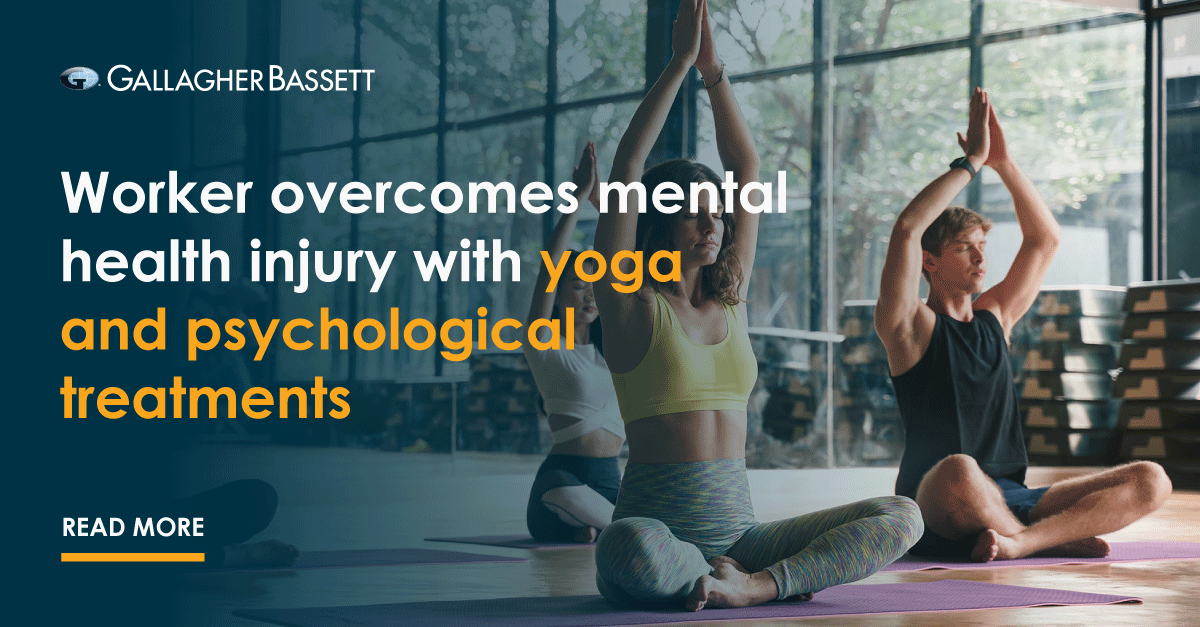Worker Overcomes Mental Health Injury with Yoga and Psychological Treatments

Combination Therapy: A Path to Recovery for Government Workers
Employees in public-facing roles are often exposed to traumatic situations that can significantly impact their mental health. Supporting their recovery requires innovative approaches that go beyond conventional methods. As part of Gallagher Bassett’s Recovery Model Office (RMO) pilot project, we explored creative, complementary therapies alongside traditional treatments. The following story illustrates how combining yoga with psychological care yielded significant benefits.
On May 28, 2019, a government employee encountered distressing graphic material while performing their duties, leading to a diagnosis of depressive mood and anxiety disorder. Due to the complex nature of the claim, it was assigned a risk score of 0.8.
Recognising the need for a holistic approach to treatment, the worker’s general practitioner recommended a psychologist who also practices yoga. The employee was eager to pursue this integrated treatment path, as research has shown that yoga can complement traditional psychological therapies by reducing stress, improving mood, and enhancing overall wellbeing. Several psychologists have received yoga training to offer this dual approach, providing patients with tools to manage conditions such as depression, anxiety, and PTSD.
Yoga, under the guidance of a trained therapist, offers both psychological and physical benefits, altering brain chemistry to improve mood and boost cognition. In some cases, it has been found to deliver more substantial mental health improvements than pharmacological treatments, although each case requires individualised assessment by a healthcare professional.
On December 14, 2019, the employee’s treatment plan, incorporating weekly yoga sessions, was approved, and sessions commenced on January 14, 2020. Each one-hour session cost $85, with the full course spanning eight sessions over two months, amounting to $850. The aim was to equip the employee with coping strategies, easing their return to work.
Throughout the sessions, the employee learned various stress reduction and relaxation techniques from the psychologist, which helped improve both their mental resilience and emotional regulation. This groundwork was critical in preparing the employee to participate in return-to-work (RTW) planning.
Unfortunately, on December 19, the employee suffered an unrelated ankle fracture, delaying their return. Despite this setback, the worker engaged in RTW discussions and by February 24, 2020, they made a partial return to work, initially working two days a week for four hours each day. The employer facilitated this return by assigning non-operational duties, minimising the risk of further mental health triggers. As the employee progressed, their schedule increased to three days a week at six hours per day, still focused on non-operational tasks.
Reflecting on the combined treatment, the employee shared, “I’ve found the yoga to be positive in relaxing my anxiety and increasing my mindfulness. I would recommend [it] to anyone who is struggling with PTSD.” The psychologist also encouraged the employee to continue practising the mindfulness and relaxation techniques learned during the sessions, to support their ongoing recovery and eventual full return to work.
For both the government agency and the employee, this holistic treatment approach proved to be a worthwhile investment. The employee experienced improved mental and emotional wellbeing, while the employer saw a valued team member reintegrated into the workplace with minimal disruption. This case underscores the importance of considering alternative therapies like yoga as part of a comprehensive recovery plan.

